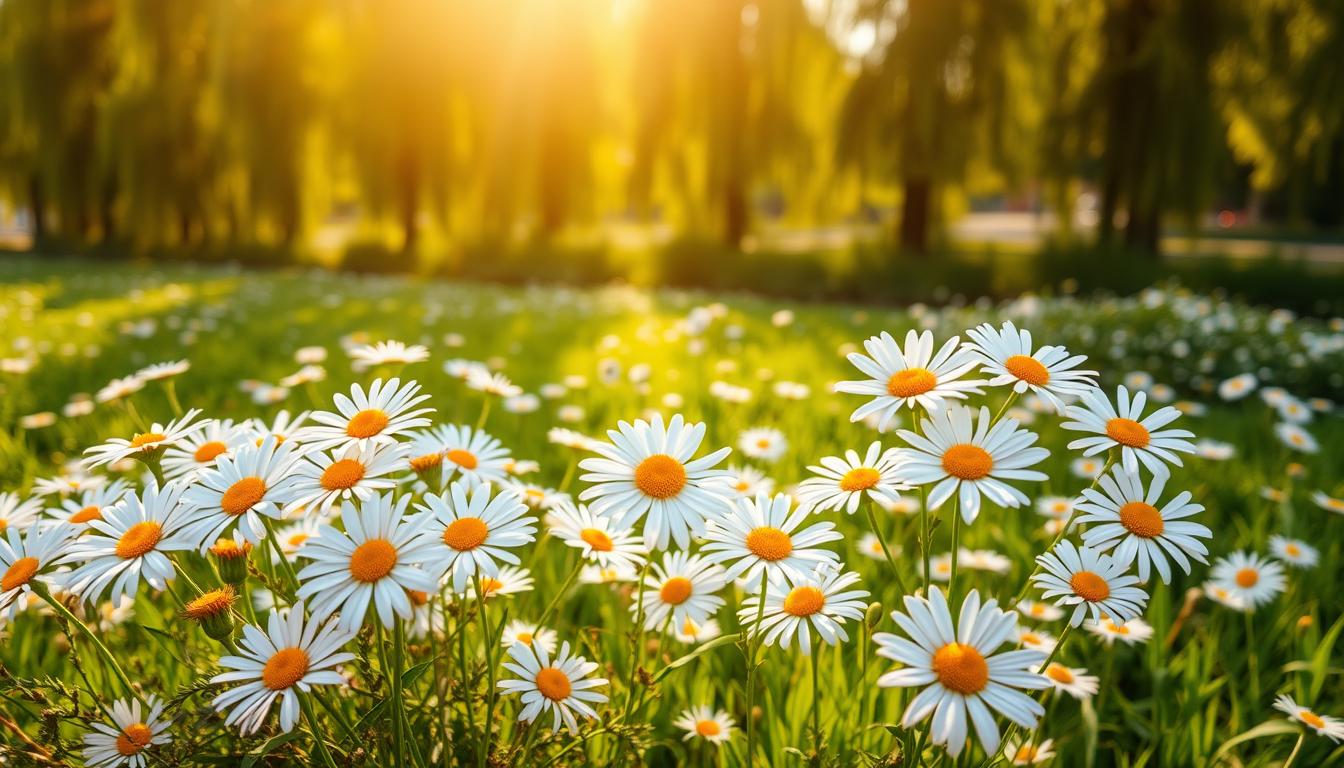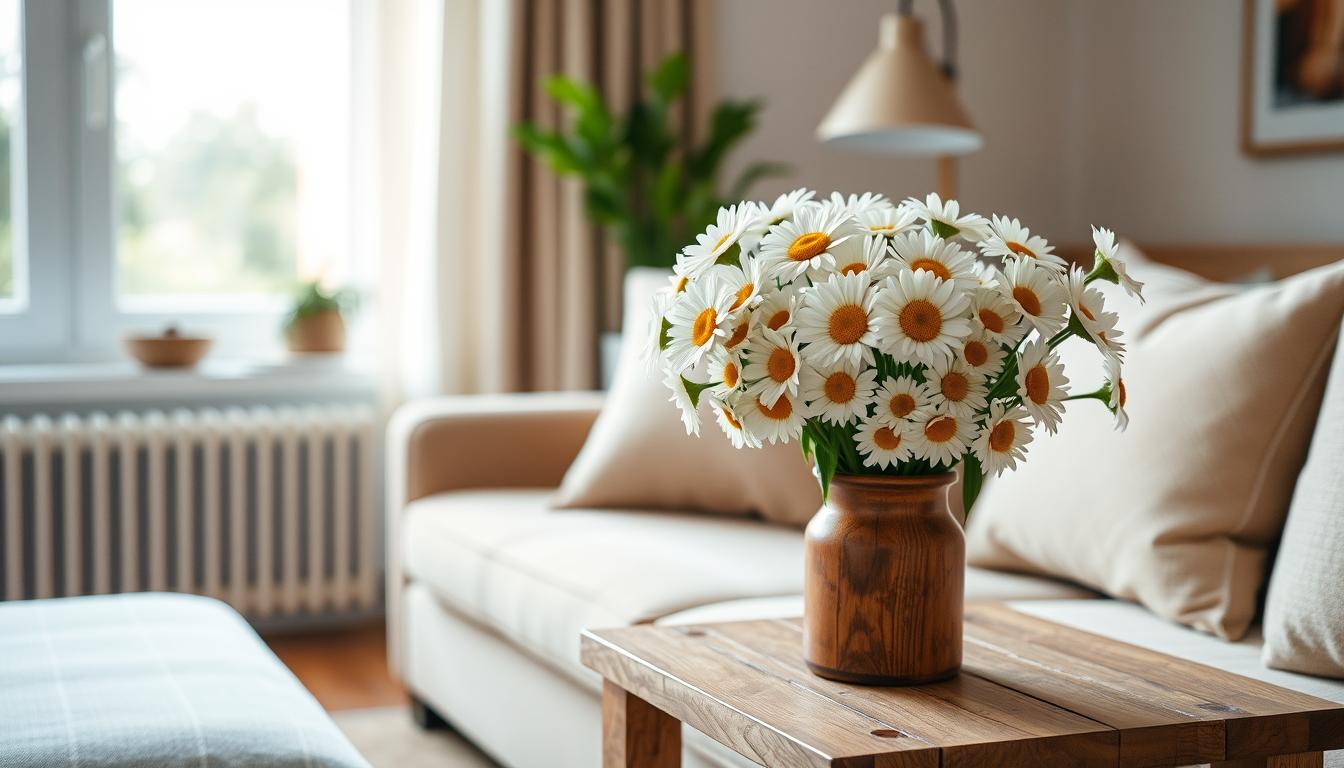
Daisy flowers have captivated gardeners and flower enthusiasts for generations with their cheerful appearance and remarkable versatility. These stunning blooms represent more than just a simple garden plant – they are living expressions of natural beauty that can transform any space with their radiant petals and delicate structure.
From backyard gardens to professional landscaping, types of daisies offer an incredible range of colors, sizes, and styles. Whether you’re a seasoned gardener or a flower novice, understanding the unique characteristics of daisy flowers can help you create breathtaking outdoor environments that inspire and delight.
This comprehensive guide will explore the enchanting world of daisies, providing insights into their cultivation, varieties, and creative uses. We’ll dive deep into everything from growing techniques to design strategies that showcase these remarkable flowers in their best light.
Key Takeaways
- Daisies are incredibly versatile garden plants
- Multiple varieties suit different landscaping needs
- Easy to grow and maintain for most gardeners
- Adaptable to various climate conditions
- Excellent for both ornamental and practical purposes
Understanding the Timeless Appeal of Daisies
Daisy flowers have captivated human imagination for centuries, weaving their delicate beauty through cultural narratives and artistic expressions. These charming blossoms represent more than just a simple garden flower – they embody a rich tapestry of symbolism and historical significance.
Cultural Significance Throughout History
Ancient civilizations recognized the unique charm of daisy flowers in multiple ways:
- Egyptian cultures associated daisies with divine innocence
- Celtic traditions considered daisies symbols of children’s purity
- Roman mythology linked daisies to transformation and renewal
Symbolic Meanings Across Cultures
Different cultures interpret daisy flowers through distinctive lenses:
| Culture | Symbolic Meaning |
|---|---|
| Victorian England | Innocence and childhood |
| Native American | Spiritual protection |
| Japanese | Simplicity and tranquility |
Popular Uses in Modern Times
Contemporary society continues to embrace daisy bouquets for various purposes:
- Wedding decorations
- Gift arrangements
- Home interior design
- Therapeutic gardening
The enduring popularity of daisy flowers demonstrates their remarkable ability to connect human emotions across generations and cultures.
Essential Guide to Growing Daisy Plants
Cultivating daisies can transform your garden into a vibrant and cheerful landscape. Successful daisy plant care requires understanding their specific growing conditions and maintaining the right environment. These resilient flowers thrive with proper attention and strategic planting techniques.
When growing daisies, selecting the right location is crucial. Most daisy varieties prefer full sun exposure and well-draining soil. Gardeners should aim to provide at least 6-8 hours of direct sunlight daily for optimal growth and flowering.
- Choose sunny garden spots with rich, fertile soil
- Ensure adequate drainage to prevent root rot
- Space plants 1-2 feet apart for proper air circulation
- Select varieties suitable for your specific climate zone
Daisy plant care involves consistent moisture management. Water deeply but infrequently, allowing soil to dry slightly between watering sessions. Overwatering can lead to root diseases and stunted growth.
| Daisy Care Aspect | Recommended Practice |
|---|---|
| Soil pH | 6.0-7.5 (Slightly acidic to neutral) |
| Watering Frequency | Once per week, depending on rainfall |
| Fertilization | Balanced, low-nitrogen fertilizer in spring |
“The secret to beautiful daisies is understanding their simple yet specific needs.” – Professional Gardener
For robust growth, apply a light layer of organic mulch around plants to retain moisture and suppress weeds. Prune spent blooms regularly to encourage continuous flowering and maintain plant health during the growing season.
By following these essential guidelines for growing daisies, gardeners can create stunning displays that brighten outdoor spaces and attract pollinators.
Popular Types of Daisies for Your Garden
Daisies are beloved flowers that bring charm and versatility to garden landscapes. Gardeners have multiple types of daisies to choose from, each offering unique characteristics and visual appeal. Whether you’re looking for classic white blooms or vibrant colors, there’s a daisy variety perfect for every garden design.
Understanding the different types of daisies can help you create a stunning and diverse garden space. Let’s explore some of the most popular daisy varieties that can transform your outdoor environment.
Shasta Daisies: The Classic Beauty
Shasta daisies are the quintessential garden flower, known for their crisp white petals and bright yellow centers. These perennial plants are incredibly resilient and can thrive in various climates. Shasta daisies typically grow 2-3 feet tall, making them perfect for mid-border garden positions.
- Bloom from early summer to fall
- Attract pollinators like butterflies
- Excellent for cut flower arrangements
Gerbera Daisies: Colorful Statement Makers
Gerbera daisies stand out with their bold, large blooms in an array of vibrant colors. These stunning flowers come in shades of pink, orange, yellow, and red. Gerbera daisies are particularly popular in modern garden designs and container plantings.
“Gerbera daisies are like living artwork in your garden” – Professional Gardener
English Daisies: Charming Ground Cover
- Grows well in partial shade
- Ideal for small garden spaces
- Provides continuous bloom in spring
Seasonal Care Tips for Thriving Daisy Gardens
Maintaining a beautiful daisy garden requires understanding the unique needs of these charming flowers throughout the year. Successful daisy plant care depends on adapting your gardening approach to each season’s specific challenges and opportunities.
Spring marks the crucial renewal period for your daisy garden. Key tasks include:
- Clearing winter debris around daisy plants
- Checking soil nutrients and adding compost
- Pruning dead or damaged stems
- Dividing perennial daisy clumps
- Water deeply but infrequently
- Mulch around plant bases to retain moisture
- Provide partial shade during extreme temperatures
- Remove spent blooms to encourage continued flowering
Winter protection involves minimal intervention. In colder regions, apply a thick layer of mulch to insulate daisy roots. In milder climates, simply ensure good drainage to prevent root rot during wet months.
Creating Stunning Daisy Bouquets and Arrangements
Crafting beautiful daisy bouquets transforms ordinary flower arrangements into extraordinary displays of natural beauty. Daisy flowers offer incredible versatility for creating memorable floral compositions that capture attention and evoke emotion.
Designing a captivating daisy bouquet requires understanding key principles of composition and color harmony. Professional florists recommend selecting fresh, vibrant daisy flowers with sturdy stems and minimal blemishes.
Color Combination Strategies
When creating daisy bouquets, consider these color pairing techniques:
- Complementary color combinations with purple or yellow accent flowers
- Pastel-themed arrangements blending soft pink and lavender daisies
Preservation Techniques
Extend the life of your daisy bouquet with professional preservation methods:
- Trim stems at a 45-degree angle before placing in water
- Use clean, room-temperature water
- Replace water every two days
- Keep arrangements away from direct sunlight
Professional Styling Tips
Professional florists recommend balancing daisy flowers with strategic design approaches. Create visual interest by varying stem lengths and incorporating greenery for depth and texture. Select containers that complement the daisy bouquet’s color palette and overall aesthetic.
The secret to a stunning daisy arrangement lies in understanding the flower’s natural grace and simplicity.
Maintaining Healthy Perennial Daisies Year-Round
Perennial daisies are beloved garden favorites that can bring beauty to your landscape for many years with proper daisy plant care. These resilient flowers require strategic maintenance to ensure they remain vibrant and healthy throughout different seasons.
Successful perennial daisies cultivation involves several key practices:
- Regular deadheading to encourage continuous blooming
- Proper division every 3-4 years to prevent overcrowding
- Strategic winter protection in colder regions
Daisy plant care starts with understanding each variety’s specific needs. Shasta daisies, for instance, thrive in full sun and well-draining soil. Gardeners should focus on creating optimal growing conditions that mimic their natural habitat.
“The secret to beautiful perennial daisies is consistent, thoughtful maintenance,” says professional gardener Sarah Thompson.
Winter preparation is crucial for perennial daisies. Cut back dead foliage after the first frost, apply a thick layer of mulch, and protect root systems from extreme cold. This approach ensures your daisies return stronger each spring.
- Apply 2-3 inches of organic mulch around plants
- Avoid overwatering during dormant months
- Check for potential pest or disease issues
By implementing these daisy plant care strategies, gardeners can enjoy stunning, long-lasting perennial daisies that transform outdoor spaces year after year.
Companion Plants That Complement Your Daisies
Creating a stunning daisy garden involves more than just selecting beautiful types of daisies. The right companion plants can transform your garden into a vibrant, harmonious landscape that showcases these charming flowers at their best.
Designing a mixed garden requires careful consideration of plant characteristics and visual dynamics. Successful companion planting can enhance the overall health and aesthetic appeal of your daisy garden.
Best Flowering Partners
- Lavender: Provides a beautiful purple contrast to white daisies
- Coneflowers: Create a complementary prairie-style look
- Black-eyed Susans: Offer similar bright, sunny appearances
- Salvia: Add vertical interest and vibrant colohttps://lifebridg.com/inspiring-valentines-day-drawing-ideas/r
Complementary Foliage Plants
Foliage plants can provide structure and texture to your daisy garden, creating depth and visual complexity:
- Ornamental grasses: Add movement and soft texture
- Hostas: Create interesting ground cover
- Ferns: Provide delicate, intricate background layers
- Sage: Offers silvery-green leaves for contrast
Design Principles for Mixed Gardens
Successful garden design with daisies involves understanding color, height, and bloom timing. Strategically place different types of daisies and companion plants to create visual rhythm and balance.
“A well-designed garden is like a living painting, with each plant playing a crucial role in the overall composition.” – Garden Design Expert
Consider layering plants with varying heights, mixing textures, and creating color gradients to maximize the visual impact of your daisy garden. The goal is to create a natural, cohesive landscape that highlights the beauty of each individual plant.
Troubleshooting Common Daisy Plant Problems
Growing daisies can be a rewarding experience, but even experienced gardeners encounter challenges. Understanding common issues in daisy plant care helps you maintain healthy and vibrant flowers throughout the season.
Pest problems frequently impact daisy plants. Gardeners should watch for specific threats that can compromise plant health:
- Aphids: Tiny insects that cluster on stems and leaves
- Spider mites: Microscopic pests causing leaf discoloration
- Slugs: Night-feeding creatures that damage daisy foliage
Disease management is crucial for successful growing daisies. Fungal infections like powdery mildew and root rot can quickly devastate your garden. Prevention strategies include:
- Ensuring proper soil drainage
- Maintaining adequate plant spacing
- Avoiding overhead watering
Environmental stressors also impact daisy plant care. Extreme temperatures, insufficient sunlight, and improper watering can weaken your plants. Monitoring these conditions helps maintain robust and blooming daisies.
Regular inspection and proactive management are key to preventing and addressing potential plant problems. By understanding these common challenges, gardeners can create thriving daisy gardens that bloom beautifully season after season.
Harvesting and Using Daisies in Home Decor

Transforming daisy flowers into stunning home decor is an art that brings natural beauty indoors. The right harvesting techniques can help you create breathtaking daisy bouquets that elevate any living space.
When cutting daisy flowers from your garden, choose the optimal time for maximum longevity. Early morning or late evening provides the best conditions for harvesting. Select blooms that are just beginning to open, ensuring they will continue to unfurl in your arrangement.
- Use sharp, clean pruning shears to prevent plant damage
- Cut stems at a 45-degree angle for better water absorption
- Remove lower leaves that might sit below the waterline
Creating memorable daisy bouquets requires strategic placement and design. Consider these creative approaches to showcase these charming flowers:
| Decor Style | Daisy Arrangement Technique |
|---|---|
| Rustic Farmhouse | Mason jar arrangements with mixed wildflowers |
| Minimalist Modern | Single-stem vases with white Shasta daisies |
| Vintage Elegance | Dried daisy wreaths and pressed flower frames |
“Daisies are like sunshine you can hold in your hand” – Unknown Garden Enthusiast
With careful harvesting and creative styling, daisy flowers can transform your home into a vibrant, welcoming space that celebrates nature’s simple elegance.
Conclusion
Daisies represent more than just a simple garden flower. These versatile daisy flowers bring joy, color, and life to gardens and landscapes across the United States. From the classic Shasta daisies to the vibrant Gerbera varieties, each type offers unique characteristics that can transform any outdoor space into a stunning botanical display.
Creating a successful daisy garden requires understanding the specific needs of these charming plants. Gardeners can maximize their success by selecting the right companion plants, providing proper seasonal care, and addressing potential growth challenges. The versatility of daisy flowers makes them an excellent choice for both novice and experienced gardeners looking to add natural beauty to their landscape.
Whether you’re interested in ornamental gardening, floral arrangements, or simply enjoying nature’s beauty, daisies offer something special for everyone. Their ability to thrive in various conditions and adapt to different garden designs makes them a remarkable addition to any outdoor space. Embrace the charm of these delightful flowers and watch your daisy garden become a vibrant, living masterpiece.
By implementing the techniques and insights shared throughout this article, you can create a breathtaking display of daisy flowers that will bring color, texture, and joy to your personal outdoor sanctuary. Start your daisy garden journey today and discover the endless possibilities these remarkable flowers can offer.
FAQ
What are the easiest daisy varieties to grow for beginners?
Shasta daisies and English daisies are excellent choices for beginners. They’re relatively low-maintenance, adaptable to various growing conditions, and can thrive in many garden settings. Shasta daisies are particularly hardy perennials that require minimal care and produce abundant white flowers with yellow centers.
How often should I water my daisy plants?
Most daisy varieties prefer consistent moisture but not waterlogged soil. Water deeply once or twice a week, depending on your climate and soil type. During hot summer months, you may need to water more frequently, ensuring the soil remains moist but not saturated. A good rule of thumb is to water when the top inch of soil feels dry to the touch.
Can daisies grow in containers?
Absolutely! Gerbera daisies and smaller daisy varieties are particularly well-suited to container gardening. Choose a pot with good drainage, use high-quality potting soil, and ensure the container is large enough to accommodate the plant’s root system. Place the container in a location that receives appropriate sunlight for the specific daisy variety.
What type of sunlight do daisies need?
Most daisy varieties thrive in full sun to partial shade. Shasta daisies typically require 6-8 hours of direct sunlight daily, while some varieties like Gerbera daisies can tolerate partial shade. The key is to provide bright, indirect light or morning sun with some afternoon protection in particularly hot climates.
How do I prevent pests from damaging my daisy plants?
Prevent pest issues by maintaining healthy plants through proper care. Use organic methods like neem oil, insecticidal soap, or introducing beneficial insects. Watch for common pests like aphids, spider mites, and whiteflies. Regularly inspect your plants, remove any infected parts, and ensure good air circulation around your daisy plants.
When is the best time to plant daisies?
The ideal planting time depends on your climate, but generally, spring or early fall are best for planting daisies. For most regions, plant after the last frost in spring or 6-8 weeks before the first expected fall frost. This gives the plants time to establish their root systems before extreme temperatures arrive.
How do I create a long-lasting daisy bouquet?
To create a long-lasting bouquet, cut daisies in the early morning when they’re well-hydrated. Use clean, sharp scissors and cut stems at a 45-degree angle. Remove lower leaves that would sit below the waterline, place in a clean vase with fresh water, and add flower food. Change water every two days and keep the bouquet away from direct sunlight and heat sources.
Are daisies perennial or annual?
Many popular daisy varieties are perennials, including Shasta daisies and some types of English daisies. These plants return year after year, becoming fuller and more established with time. However, some varieties like Gerbera daisies are often treated as annuals in colder climates but can be perennial in warmer regions.
How do I propagate daisy plants?
The most common propagation methods for daisies include division and seed planting. For perennial daisies, divide mature plants in early spring or fall by carefully separating the root clumps. For seed propagation, collect seeds from spent flowers, plant in well-prepared soil, and keep consistently moist until germination occurs.
What companion plants work well with daisies?
Excellent companion plants for daisies include lavender, coneflowers, black-eyed susans, and salvia. These plants complement daisies in color, height, and growing conditions. Consider plants with similar sunlight and water requirements to create a harmonious garden design that supports healthy plant growth.






